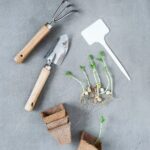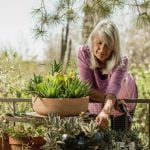Container gardening has become a popular choice for those looking to cultivate plants in limited spaces or with mobility constraints. This innovative approach allows individuals to create stunning gardens on balconies, patios, or even indoors. By utilizing containers, gardeners can easily move their plants around to optimize sunlight and space. Whether you’re a novice or seasoned gardener, container gardening offers endless possibilities for creativity and greenery.
When venturing into container gardening, selecting the right containers is crucial for the success of your plants. Factors such as plant varieties, size, and drainage requirements should be taken into consideration when choosing containers. Additionally, having the essential supplies on hand, including potting mix, fertilizer, and watering cans, will ensure that your container garden thrives and flourishes.
Looking for inspiration to elevate your container gardening game? Get creative with unique DIY containers using repurposed items or explore vertical gardening solutions to maximize space. With a wide array of flowers, herbs, vegetables, and succulents that thrive in containers, you can curate a stunning garden that suits your style and preferences. Stay tuned for practical tips on maintenance and troubleshooting common issues to keep your container garden vibrant throughout the seasons.
Choosing the Right Containers
When it comes to container gardening, choosing the right containers is crucial for the success of your plants. The first thing to consider is the size of the containers, which should be suitable for the plant varieties you plan to grow. Larger plants, such as tomatoes or peppers, will require bigger pots to accommodate their root systems and allow for proper growth. On the other hand, smaller herbs like basil or mint can thrive in smaller containers.
In addition to size, drainage is another important factor to keep in mind when selecting containers for your garden. Proper drainage is essential to prevent waterlogging and root rot, so make sure your pots have adequate drainage holes at the bottom. If you’re using decorative pots without drainage holes, consider placing a layer of gravel or stones at the bottom before adding potting mix to improve drainage.
When it comes to aesthetics, there are endless possibilities for creative containers that can add personality and style to your container garden. Consider repurposing items like old buckets, wooden crates, or even shoes as unique planters.
Vertical gardening solutions, such as hanging baskets or wall-mounted planters, are also great choices for maximizing space in small areas. Get creative with your container gardening ideas and think outside the box for a truly unique garden display that reflects your personality and style.
Essential Supplies
When it comes to successful container gardening, having the essential supplies on hand is crucial to ensure your plants thrive and flourish. From choosing the right potting mix to providing proper fertilization and watering, here are some key tools and materials you’ll need to create a bountiful container garden.
Potting Mix
One of the most important aspects of container gardening is selecting the right potting mix for your plants. It’s essential to choose a high-quality mix that provides good drainage while retaining moisture. Look for a blend specifically formulated for containers, as it will contain the right balance of peat moss, perlite, vermiculite, and other nutrients necessary for healthy plant growth.
Fertilizer
In addition to a nutrient-rich potting mix, fertilizer is essential for feeding your container plants throughout their growing season. Choose a balanced water-soluble fertilizer that contains equal parts nitrogen, phosphorus, and potassium (N-P-K). Alternatively, opt for an organic fertilizer like compost or fish emulsion for a more natural approach. Be sure to follow the recommended application rates on the packaging to prevent over-fertilizing and causing harm to your plants.
Watering Cans
Proper watering is key to maintaining healthy container plants, so investing in a quality watering can is a must-have tool for any gardener. Choose a can with a long spout or watering wand that allows for precise watering directly at the base of your plants without splashing foliage. Additionally, look for cans with adjustable flow rates to control the amount of water each plant receives based on its individual needs.
By having these essential supplies at your disposal, you’ll be well-equipped to embark on your container gardening journey with confidence and success. With the right potting mix, fertilizers, and watering tools in hand, you’ll set yourself up for a thriving garden full of beautiful blooms and bountiful harvests.
Creative Container Ideas
Container gardening is not just about the plants you choose to grow but also the containers in which you plant them. Thinking outside the box when it comes to containers can add a unique and personal touch to your garden. One creative idea is to repurpose items that you might otherwise throw away, such as old tin cans, buckets, or even broken tea cups. Not only does this reduce waste, but it also adds a quirky charm to your garden.
Vertical gardening solutions are another innovative way to maximize space in container gardening. Hanging planters, wall-mounted containers, and trellises can all be used to create a vertical garden that adds visual interest and allows you to grow more plants in a smaller area. Vertical gardens are especially useful for those with limited outdoor space or who want to add greenery to a balcony or patio.
For those with a crafty side, DIY containers offer endless possibilities for adding character to your garden. Consider painting terracotta pots in vibrant colors, creating mosaic designs on planters, or even building your own wooden planters from reclaimed materials. Not only do DIY containers allow you to showcase your creativity, but they also make great conversation pieces when entertaining guests in your outdoor space.
| Creative Container Ideas | Unique and DIY Containers |
|---|---|
| Repurposed Items | Old tin cans, buckets |
| Vertical Gardening Solutions | Hanging planters, wall-mounted containers |
| DIY Containers | Terracotta pots painting; Wooden planters from reclaimed materials |
Best Plants for Containers
When it comes to container gardening, selecting the right plants is crucial for a successful and vibrant display. Whether you are a beginner or a seasoned gardener, there are numerous options to choose from based on your preferences and gardening goals. Below are some recommendations for flowers, herbs, vegetables, and succulents that thrive in container gardens:
- Flowers: For colorful blooms all season long, consider planting petunias, geraniums, marigolds, or pansies in your containers. These annual flowers are easy to care for and add a pop of color to any outdoor space.
- Herbs: Fresh herbs like basil, thyme, rosemary, and mint not only provide culinary benefits but also add fragrance and beauty to your container garden. They can be grown together in larger pots or individually for a varied herb collection.
- Vegetables: If you want to grow your own produce but have limited space, try planting tomatoes, peppers, lettuce, or radishes in containers. Vegetables like cherry tomatoes and compact varieties of peppers thrive in pots and require minimal maintenance.
- Succulents: Succulents are ideal for container gardening due to their low water requirements and unique shapes and colors. Varieties like echeveria, sedum, aeonium, and jade plants are perfect for creating stunning desert-inspired displays.
With the right plant selections suited for containers gardening ideas you can easily create a beautiful oasis even in the smallest of spaces. Experiment with different combinations of flowers, herbs, vegetables, and succulents to design a custom container garden that reflects your personal style and tastes.
Remember to consider the sunlight exposure and watering needs of each plant when planning your container garden. By selecting plants that complement each other’s growth habits and care requirements well you can ensure a flourishing and harmonious mini-garden that will bring joy throughout the seasons.
Container Garden Maintenance
Container gardening offers a convenient way to cultivate plants in limited spaces, making it an ideal option for urban dwellers or those with mobility challenges. Proper maintenance is essential to keep your container garden thriving. One of the key elements of maintenance is ensuring your plants receive adequate water.
The frequency of watering will vary based on factors such as the type of plant, pot size, and weather conditions. It’s important to check the soil regularly to assess moisture levels and adjust your watering schedule accordingly.
In addition to watering, fertilizing is crucial for the health and growth of your container plants. Choose a fertilizer that is suitable for the specific needs of your plants, whether they are flowering, fruiting, or leafy greens. Be mindful not to over-fertilize, as this can cause nutrient imbalances and harm your plants. Follow the instructions on the fertilizer package and apply it at the recommended intervals to promote healthy growth.
Pruning is another aspect of container garden maintenance that should not be overlooked. Regularly trimming dead or yellowing leaves, spent flowers, and unruly growth helps improve air circulation and encourages new growth. Pruning also helps maintain the shape and appearance of your plants.
Use clean, sharp tools to make precise cuts without causing damage to the plant. By incorporating proper watering, fertilizing, and pruning practices into your routine, you can ensure that your container garden remains vibrant and healthy throughout the growing season.
| Maintenance Task | Guidelines |
|---|---|
| Watering | Check soil moisture regularly; adjust watering frequency based on plant needs. |
| Fertilizing | Select appropriate fertilizer; avoid over-fertilizing; follow instructions for application. |
| Pruning | Remove dead or yellowing leaves; trim spent flowers; maintain plant shape. |
Seasonal Container Gardening
Container gardening is a versatile and practical way to enjoy gardening even with limited space or mobility. One of the great advantages of container gardening is the flexibility it offers when transitioning through different seasons and weather conditions. Whether you’re dealing with frost in the winter or scorching heat in the summer, there are ways to adapt your container garden to thrive all year round.
To successfully transition your container garden through different seasons, it’s essential to know which plants are suitable for each time of the year. Consider planting seasonal flowers like tulips and daffodils in the spring, followed by heat-tolerant plants like zinnias and marigolds in the summer. For fall, opt for mums and pansies that can withstand cooler temperatures, and switch to evergreens like holly and juniper for winter interest.
Here are some tips on how to manage your container garden as the seasons change:
- Regularly check soil moisture levels: Adjust your watering schedule based on weather conditions. Plants may need more frequent watering during hot summers or less water during rainy seasons.
- Monitor plant growth: Trim back any dead or overgrown foliage to encourage new growth and maintain a neat appearance.
- Protect your plants: Use frost cloth or move containers indoors during cold snaps to prevent damage from frost. Provide shade cloth or move containers to a shadier spot during heatwaves to shield plants from excessive sun exposure.
By following these seasonal container gardening tips, you can enjoy a thriving garden no matter what Mother Nature throws your way. Experiment with different plant combinations and container styles to create a beautiful display that evolves with each passing season. With a little planning and care, you can have a successful container garden that brightens up your outdoor space all year long.
Troubleshooting Common Issues
Container gardening is a fantastic way to bring the beauty of nature into your home, even if you have limited space or mobility. By choosing the right containers and plants, you can create a lush and vibrant garden that brightens up your living space. With the right tools and materials, as well as proper maintenance techniques, you can ensure that your container garden flourishes throughout the year.
One common concern for container gardeners is dealing with pests, diseases, and nutrient deficiencies. However, with some simple solutions and preventative measures, you can keep these issues at bay. Regularly inspecting your plants for signs of pests or diseases, such as discolored leaves or unusual spots, can help you catch problems early on. Using organic pest control methods and disease-resistant plant varieties can also help prevent issues from arising in the first place.
In addition to pest control, it’s essential to monitor nutrient levels in your container garden. Making sure your plants receive the proper balance of fertilizer and minerals will help them grow strong and healthy.
If you notice any signs of nutrient deficiencies, such as yellowing leaves or stunted growth, adjusting your fertilization routine or using specialized plant food can often remedy the issue. By staying vigilant and proactive in troubleshooting common problems in container gardening, you can enjoy a flourishing oasis of greenery right at your fingertips.
Frequently Asked Questions
What Foods Are Good for Container Gardening?
Container gardening allows for a wide variety of foods to be grown, including herbs like basil, mint, and cilantro. Vegetables such as tomatoes, peppers, lettuce, and radishes also thrive in containers. Fruits like strawberries and blueberries can do well too.
How Do I Make My Container Garden Look Nice?
To make your container garden look nice, consider the aesthetic appeal of your containers. Choose pots that complement each other and your space. Additionally, mix different types of plants with varying heights, colors, and textures to create visual interest.
What Can You Plant in a Container Garden?
There is a wide range of plants that can be successfully grown in a container garden. In addition to herbs and vegetables, flowers like petunias, pansies, and marigolds are popular choices for container gardening due to their bright colors and ease of care.
Succulents and cacti are also excellent options for those looking for low-maintenance plants to grow in containers.

Welcome to my gardening blog! I am passionate about plants and enjoy sharing my knowledge and experiences with others. In this blog, I will write about everything related to gardening, from tips on how to get started to updates on my own garden projects.





